
Mission San Buenaventura, formally known as the Mission Basilica of San Buenaventura, is a Catholic parish and basilica in the Archdiocese of Los Angeles. The parish church in the city of Ventura, California, United States, is a Spanish mission founded by the Order of Friars Minor. Founded on March 31, 1782, it was the ninth Spanish mission established in Alta California and the last to be established by the head of the Franciscan missions in California, Junípero Serra. Designated a California Historical Landmark, the mission is one of many locally designated landmarks in downtown Ventura.

Ventura County is a county located in the southern part of the U.S. state of California. As of the 2020 census, the population was 843,843. The largest city is Oxnard, and the county seat is the city of Ventura.

Ventura, officially named San Buenaventura, is a city in and the county seat of Ventura County, California, United States. It is a coastal city located northwest of Los Angeles. The population was 110,763 at the 2020 census. Ventura is a popular tourist destination, owing to its historic landmarks, beaches, and resorts.

The Santa Clara River is an 83 mi (134 km) long river in Ventura and Los Angeles counties in Southern California. It drains parts of four ranges in the Transverse Ranges System north and northwest of Los Angeles, then flows west onto the Oxnard Plain and into the Santa Barbara Channel of the Pacific Ocean.

The Ventura County Courthouse, known since 1974 as Ventura City Hall, is a historic building in Ventura, California. It is located on a hill at the top of California Street, overlooking the city's downtown district with views of the Santa Barbara Channel and Channel Islands. It was the first building in the City of Ventura to be listed on the National Register of Historic Places and has also received historic designations at the state, county and city levels.

Wagon Wheel is a densely populated, planned neighborhood of Oxnard, California at the intersection of U.S. Route 101 and Oxnard Boulevard. The neighborhood was originally developed as an office, motel, and restaurant complex named Wagon Wheel Junction with a convenient roadside location near the historic community of El Rio. The site in Ventura County became a popular stop for travelers between Los Angeles and Santa Barbara, particularly during its heyday in the 1950s, 1960s and 1970s. The entire site was demolished in 2011 to begin the development of the community with 1,500 residential units.

Mount Rubidoux is a mountain just west of downtown in the city of Riverside, California, United States, that has been designated a city park and landmark. The mountain was once a popular Southern California tourist destination and is still the site of the oldest outdoor non-denominational Easter Sunrise service in the United States. Many historic markers and memorials have been placed on the mountain, the most prominent being the cross at the summit dedicated to Father Junípero Serra. A majority of Mt. Rubidoux is owned by the City of Riverside, while 0.43 acres at the peak is owned by Rivers & Lands Conservancy after the cross attracted a potential lawsuit and the city decided to sell it at auction it to a private organization.

The San Buenaventura Mission Aqueduct was a seven-mile long, stone and mortar aqueduct built in the late 18th and/or early 19th century to transport water from the Ventura River to the Mission San Buenaventura in Ventura, California.

Elizabeth Bard Memorial Hospital, now known as The Elizabeth Bard Memorial Building, is a historic building in downtown Ventura, California. Built in 1901, it is a Mission Revival structure featuring covered terraces and a covered porch with a three-story bell tower at the southeast corner. The building was listed as Ventura Historic Landmark No. 19 in 1976 and was added to the National Register of Historic Places in 1977.
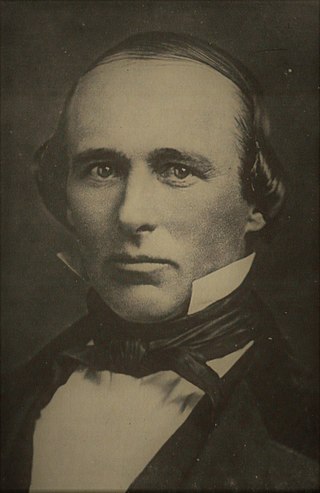
Rancho Ex-Mission San Buenaventura was a 48,823-acre (197.58 km2) Mexican land grant in present-day Ventura County, California given in 1846 by Governor Pío Pico to José de Arnaz. The grant derives its name from the secularized Mission San Buenaventura, and was called ex-Mission because of a division made of the lands held in the name of the Mission — the church retaining the grounds immediately around, and all of the lands outside of this are called ex-Mission lands. The grant extended east from present day Ventura, excluding the Rancho San Miguel (Olivas) lands, inland up the Santa Clara River to Santa Paula, between the north bank of the River and Sulphur Mountain.
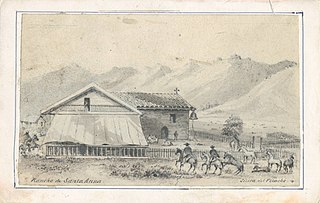
Rancho Santa Ana was a 21,522-acre (87.10 km2) Mexican land grant in present day Ventura County, California given in 1837 by Governor Juan Alvarado to Crisogono Ayala and Cosme Vanegas. Rancho Santa Ana was located inland in the Ventura River Valley on the west side of the Ventura River across from Rancho Ojai which was granted in the same year. Rancho Santa Ana encompassed present day Lake Casitas and Oak View.
The San Buenaventura Conservancy for Preservation is an historic preservation organization in Ventura, California also known by its early name of San Buenaventura. It works to recognize and revitalize historic, archeological and cultural resources in the region. The Conservancy is a non-profit 501c3 organization. The group was formed in 2004 after the demolition of the Mayfair Theater, an S. Charles Lee, Streamline Moderne, movie theater in downtown Ventura, California that was razed and replaced with a condominium project.
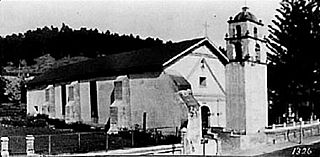
The City of Ventura Historic Landmarks and Districts consist of buildings, sites, and neighborhoods designated by the City of Ventura, California, as historic landmarks and districts.

Ortega Adobe is a historic adobe house built in 1857 and located on Main Street on the west side of Ventura, California, not far from the mouth of the Ventura River. It was designated in 1974 as the City of Ventura's Historic Landmark No. 2. It is owned by the City and operated as a self-guided historical site.
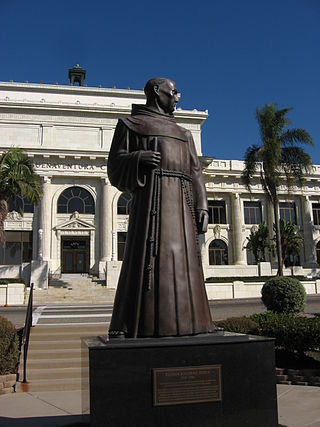
The Father Serra statue in Ventura, California, representing Junípero Serra, the founder of Mission San Buenaventura, was commissioned by Ventura County through the Works Progress Administration as part of the Federal Art Project in 1935. This statue, made of concrete from a clay model by Uno John Palo Kangas, was placed in a prominent location in a public park across the street from the Ventura County Courthouse in 1936. After the Courthouse was repurposed as Ventura City Hall, the statue was designated as City of Ventura Historic Landmark No. 3 in 1974. As deterioration of the concrete statue became a concern, a wood replica was created by local carvers and used to make a bronze cast. The concrete statue was replaced by the bronze cast in 1989. The wood replica was set in the atrium of the city hall for public display.

The Peirano Market, also known as Peirano's Grocery and Peirano Store, is a historic building in Ventura, California. Located across the street from the Mission San Buenaventura, the red brick structure was built in 1877 and has ornamental relief brickwork and a mansard, Spanish revival tile roof.
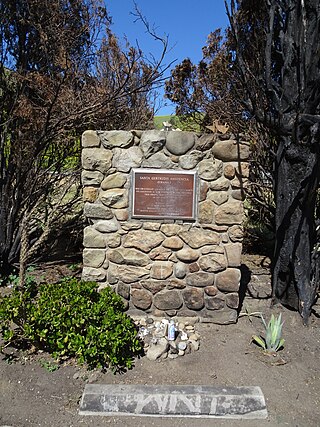
The Santa Gertrudis Asistencia, also known as the Santa Gertrudis Chapel, was an asistencia ("sub-mission") to the Mission San Buenaventura, part of the system of Spanish missions in Las Californias—Alta California. Built at an unknown date between 1792 and 1809, it was located approximately five miles from the main mission, inland and upstream along the Ventura River. The site was buried in 1968 by the construction of California State Route 33. Prior to the freeway's construction, archaeologists excavated and studied the site. A number of foundation stones were moved and used to create the Santa Gertrudis Asistencia Monument which was designated in 1970 as Ventura County Historic Landmark No. 11.

Eugene Preston Foster, commonly known as E. P. Foster, was a rancher, entrepreneur, banker, and philanthropist in Ventura County, California.

The Battle of San Buenaventura was a battle fought on March 27 and March 28, 1838, between forces representing competing claims to the governorship of California, then a Mexican territory. The opposing forces consisted of supporters of Juan Bautista Alvarado based in Northern California and supporters of Carlos Antonio Carrillo from Southern California. The major action consisted of a cannon siege on the Carrillo loyalists who were encamped at the Mission San Buenaventura in Ventura, California. The Alvarado forces won the battle, as the Carrillo forces fled from the Mission under cover of darkness following the first day of the battle. Most of the Carillo forces were captured the following day at Saticoy, California. One person was killed in the battle, an Alvarado loyalist who was shot by a rifleman stationed in the Mission's bell tower.



















